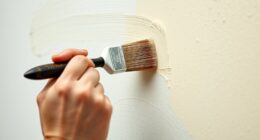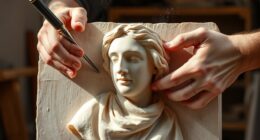To excel in knife carving, choose knives suited for detailed work, ensuring you handle them with a proper grip like a precision hold for better control. Keep your blades sharp by regular honing and cleaning, and store them in protective sheaths or on magnetic strips to prevent dulling. Regularly inspect your blades for damage and replace them when needed. Mastering these skills boosts your confidence and craftsmanship—keep exploring to learn more about mastering your tools.
Key Takeaways
- Choose knives with fine, sharp blades suited for detailed carving work to ensure precision and control.
- Use a proper grip, such as a precision grip, to improve accuracy and safety during carving.
- Regularly hone and sharpen blades with sharpening stones or rods to maintain optimal sharpness.
- Store knives in protective sheaths or on magnetic strips to prevent dulling and damage.
- Inspect blades frequently for chips or damage, and replace or repair as needed to ensure safety and quality.

Have you ever wondered how skilled artisans transform a simple piece of wood into intricate art? It all begins with choosing the right knife and mastering proper techniques. When you’re starting out, focusing on your grip and maintaining your blades makes all the difference. A precision grip is essential—grip the knife firmly yet comfortably, allowing you to control every cut with accuracy. This grip minimizes slips and helps you carve with steady, deliberate motions, which is vital for detailed work. You’ll find that holding the knife correctly increases your confidence and reduces fatigue, especially during long carving sessions.
But even the best technique won’t matter if you neglect blade maintenance. Keeping your knives sharp is key to achieving clean, precise cuts. A dull blade requires more force, which can lead to slips, accidents, and uneven carving. Regularly honing your blades with a sharpening stone or a honing rod ensures they stay razor-sharp. Remember, a sharp knife doesn’t just improve the quality of your work; it also enhances safety. When your blades are well-maintained, you exert less pressure, giving you better control and reducing the risk of injury.
Proper storage is part of blade maintenance too. Store your knives in a protective sheath or on a magnetic strip to prevent dulling or accidental damage. Avoid tossing them loosely into a drawer, as this can nick or chip the edges. Cleaning your knives after each use is equally important—wipe them down to remove debris and moisture, which can cause rust or corrosion over time. Using a mild soap and dry cloth keeps the blades in top condition. When it’s time to sharpen, follow the specific instructions for your knife’s steel type and angle; investing in a quality sharpening system can make this task easier and more effective.
In addition to sharpening, regularly inspecting your knives for damage is wise. Chips or bends mean you should repair or replace the blade before continuing your work. Remember, the right knife combined with proper blade maintenance not only guarantees safety but also elevates your craftsmanship. You’ll notice that your carvings become more refined, and your confidence grows with each project. Whether you’re shaping delicate details or roughing out a larger piece, a well-maintained blade and a precise grip are your best tools. Embrace these habits, and you’ll find that knife carving becomes more enjoyable, with results that showcase your skill and dedication. Additionally, understanding the importance of color accuracy can help you select knives that provide better visibility and control for intricate work.
Frequently Asked Questions
What Safety Gear Should I Wear During Knife Carving?
When knife carving, you should wear protective gloves to prevent cuts and safety goggles to shield your eyes from any flying debris. These safety gear items help you stay safe while maintaining control over your carving tools. Always guarantee your gloves fit well and are cut-resistant, and your goggles are snug. Staying protected allows you to focus on your craftsmanship without worrying about potential injuries.
How Do I Prevent Knife Rust and Corrosion?
To prevent knife rust and corrosion, you should focus on proper knife maintenance. Always dry your knives thoroughly after use and store them in a dry place. Apply a light coat of mineral oil or knife oil regularly to protect the blade. Avoid leaving your knives in water or humid environments, as moisture accelerates rust formation. Proper care and rust prevention techniques keep your knives sharp and in great condition longer.
Can I Customize or Sharpen My Carving Knives?
Yes, you can customize and sharpen your carving knives. For knife customization, consider professional regrinding or handle upgrades to improve grip and aesthetics. When sharpening, use proper techniques like honing with a whetstone or a sharpening steel to maintain a keen edge. Regular sharpening keeps your knives performing at their best, and customized handles can enhance comfort and control during carving. Always follow safe practices to protect yourself and your tools.
What Are the Best Storage Solutions for Carving Knives?
Your knife collection deserves a fortress of safety! Use knife sheathes for individual protection and to prevent accidents, especially for travel or storage. For everyday use, a sturdy knife storage rack keeps your carving knives organized and easily accessible, while preventing damage. Both options safeguard your blades and extend their lifespan. Choose a solution that fits your space and habits, ensuring your knives remain sharp, safe, and ready for your next masterpiece.
How Do I Identify High-Quality Carving Knife Brands?
You can identify high-quality carving knife brands by examining their reputation and the materials used. Look for brands known for craftsmanship and durability, like those utilizing high-carbon stainless steel for the knife blades. A trusted brand’s reputation often indicates consistent quality and customer satisfaction. Additionally, research reviews and expert opinions to verify the brand’s knives meet your carving needs, providing sharpness, balance, and long-lasting performance.
Conclusion
Choosing and caring for your knives is like tending a delicate garden—you must nurture them properly to see beauty flourish. With the right tools and maintenance, your carving skills will blossom, transforming simple materials into works of art. Keep your knives sharp and clean, and they’ll serve you like loyal companions on your creative journey. When you treat your tools with respect, they’ll reward you with precision and grace, turning every project into a masterpiece.








